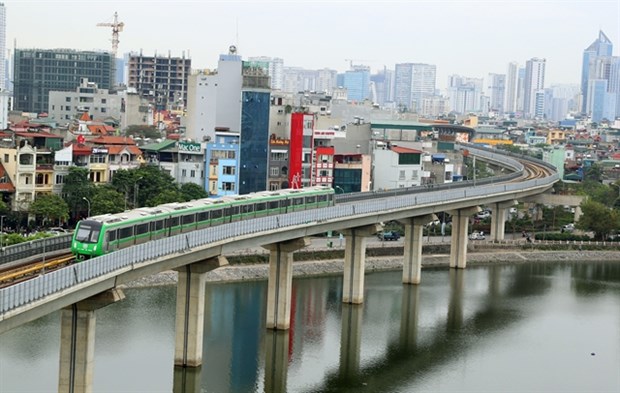Urban railway helps reduce carbon emissions: JICA
Urban railways are a way to cut carbon emissions in big cities like Hanoi and Ho Chi Minh City, according to experts from the Japan International Cooperation Agency (JICA).

A train of Cat Linh - Ha Dong urban railway project runs on trial in Hanoi. (Photo: VNA)
JICA has worked with the Climate Change Department under the Vietnamese Ministry of Natural Resources and Environment to conduct data collection surveys to develop a measurement, report and verification system for the urban railway sector in Vietnam.
The survey is being conducted between February 2019 and September 2020 to estimate the potential carbon emissions of three urban railway lines in Hanoi and HCM City which use Japan’s official development assistance (ODA).
It aims to serve as a foundation to encourage the use of transport which has low carbon emissions, including urban railways.
JICA's survey has found urban railways are a form of transport with lower carbon emissions than cars and motorbikes.
According to Associate Professor Dinh Van Hiep from National University of Civil Engineering, a train releases 14 grams of carbon dioxide per passenger per km, much lower than 42g discharged by a car and 72g emitted by a motorbike.
“Urban railway is the best choice in terms of carbon dioxide reduction when compared to other means of transport,” he said.
If urban railway systems develop to meet public demand, cities like Hanoi and HCM City will contribute to the national target of cutting greenhouse gas emissions as committed by the Government in the nationally-determined contribution programme.
JICA experts said urban railways can not only reduce carbon emission but also tackle traffic congestion and air pollution, especially in Asian cities where traffic jams affect people every day and air quality is worsening.
Ken Kumazawa, head of JICA research team, told Viet Nam News that the transport sector is a big emission source, but that urban railways can cut emissions, adding that urban railways in Bangkok reduced 30 percent of carbon dioxide emissions, so Hanoi and HCM City could do the same.
Hanoi’s current public transport system is made up of city buses and Bus Rapid Transit. Nine urban railway projects are in the city’s public transport plan, some of which are under construction.
By 2020, Hanoi authorities aim for public transport to meet about 25 percent of travel demand, with urban railways taking 2 to 3 percent.
By 2030, public transport of the capital city is hoped to meet 40 percent of travel demand, and urban railways 17 percent.
However, the operation date for these urban railway projects is unclear, so realisation of the target will also be delayed, Associate Professor Hiep said.
According to Dr Tran Minh Tu, an expert in the transport sector and a member of the JICA research team, Vietnam aims to cut greenhouse gas emissions as part of commitments to the UN.
Twice a year, Vietnam has to submit a report to the UN on emission reduction, and urban railway projects are part of the transport sector’s activities to contribute to carbon dioxide emission reduction. However, there is a lack of methodology in Vietnam to measure, report and verify carbon dioxide emissions.
JICA has conducted the survey to develop a measurement, report and verification system in the urban railway sector to find a simple method to collect emission data so Vietnamese agencies can apply it.
To estimate emission reductions through urban railway projects, in the first half of this year, the JICA research team interviewed more than 4,000 commuters living less than one km from urban railway lines No 1 (Yen Vien-Ngoc Hoi) and No 2 (Nam Thang Long-Tran Hung Dao) in Hanoi and metro line No 1 (Ben Thanh-Suoi Tien) in HCM City.
“66 percent of surveyed people in line 1 and 30 percent of line 2 in Hanoi showed readiness to use the urban railway.
“In fact, only a few of them, less than 10 percent, are using public transport now, mainly buses. The reasons others do not want to change their means of transport are inconvenient routes and their preference for private vehicles,” he told Viet Nam News.
The survey results were similar to another conducted by JICA four to five years ago on nearly 20,000 households in Hanoi. Only 4 to 6 percent of interviewees used buses, Tu said.
“These results have not satisfied the city’s expectation of developing the public transport network,” he said.
From Japan’s experience, Ken Kumazawa said urban railways had become a daily part of Japanese life. In Vietnam where most people use motorbikes, getting them to change to urban railway would be a big issue.
He said service quality would help people determine whether to change their travel habits or not.

Leave your comment on this story